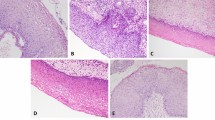Abstract
PURPOSE: The incidence of anogenital squamous-cell carcinoma was observed to have increased since the beginning of the human immunodeficiency virus infection epidemic among male homosexuals, both with acquired immunodeficiency syndrome and without acquired immunodeficiency syndrome. It seems that immunosuppression is the most important risk factor for the progression of anogenital lesions, recurrences of anal condyloma, and development of anal carcinoma, in particular in acquired immunodeficiency syndrome. High-grade anal intraepithelial neoplasia was predominantly observed in the human immunodeficiency virus-positive men. We have also observed a high rate of recurrences of anal lesions in cases of high-grade anal intraepithelial neoplasia. However, there are many cases of recurrences of low-grade anal intraepithelial neoplasia that cannot be predicted by routine histologic studies. By using immunohistochemical methods, we studied the expression of Ki-67 in epithelial cells of low-grade anal intraepithelial neoplasia of patients with acquired immunodeficiency syndrome to try to predict recurrence of these lesions. METHODS: Anal biopsies of 38 patients were studied retrospectively. Of these patients, 14 had no recurrences (Group 1), and 24 patients had recurrence of the anal lesions before one year of follow-up (Group 2). RESULTS: The median percentage of Ki-67-positive cells in Group 1 was 6.3±7.03 and in Group 2 was 24.1±16,72. The difference between Groups 1 and 2 was statistically significant (P<0.001). CONCLUSIONS: Our results showed a high correlation between the percentage of Ki-67-positive cells and recurrences. We concluded that Ki-67 counting in low-grade anal intraepithelial neoplasia can aid in predicting recurrences and therefore aid in the follow-up of these patients.
Similar content being viewed by others
References
Devictor B, Bonnier P, Piana L,et al. c-myc protein and Ki-67 antigen immunodetection in patients with uterine cervix neoplasia: correlation of microcytophotometric analysis and histological data. Gynecol Oncol 1993;49:284–90.
Al Saleh W, Delvenne P, Greimers R, Fridman V, Doyen J, Boniver J. Assessment of Ki-67 antigen immunostaining in squamous intraepithelial lesions of the uterine cervix. Correlation with the histologic grade and human papillomavirus type. Am J Clin Pathol 1995;104:154–62.
Bar JK, Harlozinska A, Markowska J, Nowak M. Studies on tumor proliferation using monoclonal antibody, Ki-67 and expression of p53 in cancer of the uterine cervix. Eur J Gynaecol Oncol 1996;17:378–80.
Ranki A, Lassus J, Niemi KM. Relation of p53 tumor suppressor protein expression to human papillomavirus (HPV) DNA and to cellular atypia in male genital warts and in premalignant lesions. Acta Derm Venereol 1995;75:180–6.
Croxson T, Chabon B, Rorat E, Barash IM. Intraepithelial carcinoma of the anus in homosexual men. Dis Colon Rectum 1984;27:325–30.
Penn I. Cancers of the anogenital region in renal transplant recipients. Analysis of 65 cases. Cancer 1986;58:611–6.
Laurent R. Genital papillomavirus infections. Rev Prat 1996;46:1961–8.
Metcalf AM, Dean T. Risk of dysplasia in anal condyloma. Surgery 1995;118:724–6.
Hsu SM, Raine L, Fanger H. The use of antiavidin antibody and avidin-biotin peroxidase complex in immunoperoxidase techniques. Am J Clin Pathol 1981;75:816–20.
Feingold AR, Vermund SH, Burk RD,et al. Cervical cytologic abnormalities and papillomavirus in women infected with human immunodeficiency virus. J Acquir Immune Defic Syndr 1990;3:896–903.
Scheafer A, Friedman W, Mielke M, Schwartlander B, Koch MA. The increased frequency of cervical dysplasia-neoplasia in women infected with the human immunodeficiency virus is related to the degree of immunosuppression. Am J Obstet Gynecol 1991;164:593–9.
Johnson JC, Burnett AF, Willet GD, Young MA, Doniger J. High frequency of latent and clinical human papillomavirus cervical infections in immunocompromised human immunodeficiency virus women. Obstet Gynecol 1992;79:321–7.
Maiman M, Fruchter R, Serur E, Levine PA, Arrastia CD, Sedlis A. Recurrent cervical intraepithelial neoplasia in human immunodeficiency virus seropositive women. Obstet Gynecol 1993;82:170–4.
Calore EE, Cavaliere MJ, Shirata NK, Araújo MF. Papillomavirus in cervicovaginal smears of women infected with human immunodeficiency virus. São Paulo Med J 1995;113:1009–11.
Schrager LK, Friedland GH, Maude D,et al. Cervical and vaginal squamous cell abnormalities on women infected with human immunodeficiency virus. J Acquir Immune Defic Syndr 1989;2:570–5.
Calore EE, Cavaliere MJ, Calore NM. Squamous intraepithelial lesions in cervical smears of human immunodeficiency virus-seropositive adolescents. Diagn Cytopathol 1998;18:91–2.
Syrjänen SM, von Krogh G, Syrjänen KJ. Detection of human papillomavirus DNA in anogenital condylomata in men using in situ DNA hybridisation applied to paraffin sections. Genitourin Med 1987;63:32–9.
Wells M, Griffiths S, Lewis F, Bird CC. Demonstration of human papillomavirus types in paraffin processed tissue from human ano-genital lesions by in-situ DNA hybridisation. J Pathol 1987;152:77–82.
Palefsky JM, Holly EA, Gonzales J, Berline J, Ahn DK, Greenspan JS. Detection of human papillomavirus DNA in anal intraepithelial neoplasia and anal cancer. Cancer Res 1991;51:1014–9.
Author information
Authors and Affiliations
About this article
Cite this article
Calore, E.E., Nadal, S.R., Manzione, C.R. et al. Expression of Ki-67 can assist in predicting recurrences of low-grade anal intraepithelial neoplasia in AIDS. Dis Colon Rectum 44, 534–537 (2001). https://doi.org/10.1007/BF02234325
Issue Date:
DOI: https://doi.org/10.1007/BF02234325




